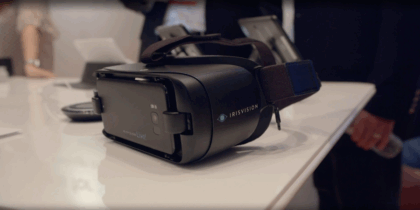Artificial intelligence and machine learning have been getting a lot of attention when it comes to disruptive technology, but virtual reality (VR) and augmented reality (AR) promise to be equally disruptive. Samsung Business Insights recently chatted with Josh Sackman, president of appliedVR, to learn more about where VR and AR are headed and what their impact might be now and in the future. Tune into the Business Disrupted podcast, Episode 5: The Business Benefits of Virtual Reality and Augmented Reality to hear the whole conversation.
Q: There’s a lot of excitement about virtual and augmented reality right now. What type of virtual reality application do you see adding the most value?
Sackman: From the consumer perspective, when you think about gaming and entertainment, virtual reality has not really enhanced the way people consume entertainment. However, in spaces like healthcare, VR provides a unique value.
Outside of traditional pharmaceutical drugs, there isn’t a whole lot to aid patients dealing with different chronic disease states, anxiety or pain. VR has real utility to the patient by transporting them somewhere that’s more conducive to relaxing, so they can cope with their situation or to allow them to learn in more experiential, fun and engaging ways.
Having a VR alternative drives value for the healthcare system by introducing new modalities of therapeutic treatment through an educational delivery that leads to better retention and engagement from patients.
Q: As digital transformation in the workplace continues, where does a virtual reality application fit into the picture?
Sackman: It takes time for organizations to identify where new technologies fit into creating value and to be able to demonstrate that value. For example, with healthcare, as much as VR helps patients feel better, if you can’t demonstrate the economic value the technology won’t be adopted at scale.
Organizations can use this time, while the technology is still nascent, to learn where VR sits within their organization, how it aligns with existing strategic initiatives, and where it fits into their technological offerings. A virtual reality application shouldn’t be seen as inherently different from other content experiences. It should be an extension of the different ways that they enhance communication, train employees, and strengthen ties and connections with customers or employees to deliver content that engages in new ways.
Q: From an organizational standpoint, is it important to have C-suite buy-in or is this a case where a sandbox departmental use case is more effective in moving a virtual reality application forward?
Sackman: There’s not a clear answer. In fact, it often helps to do both. You need ground level experimentation, adoption of the technology, development, pilots and tests to collect data that’s not hindered by too much high-level oversight. At the same time as experimentation is going on, you also need the C-suite and higher levels of the organization to understand the value and start thinking strategically around where the application fits in so that as the project escalates to higher levels there are the resources and empowerment for the organization to continue developing the technology.
Listen to the Podcast
Hear more insights from Josh Sackman, AR/VR consultant Charlie Fink and Zappar's Keith Curtin. Download Now
What often happens is, there’s some low-level success on the ground, whether it’s a marketing campaign or some pilot in a specific department of a clinic. Then the question is about scale and how does this go from some small win to some organizational strong point? That’s where you need alignment from both people on the ground who are lower level in the organization as well as the C-suite.
Q: What excites you most about the possibilities for a virtual reality application?
Sackman: Where I see really interesting VR use cases, and what I’m really drawn towards, are the areas where VR can help aid and build empathy by expanding people’s experience perspective and reach in the world. Especially for people who are confined or don’t have the fiscal resources to physically travel, VR is a really empowering thing.
Most human growth comes through experience. VR is just a way to hack that by artificially creating new experiences. There’s a lot of room for that to go wrong, but there’s also a lot of room to create things that enrich people’s lives. As we understand best practices and standards and get experience with the design and development of content, we can do this better. That’s where VR becomes really powerful and [where] I get excited.
Q: As we wrap up our discussion today, what thoughts would you like to leave on digital transformation in the workplace and the applications for virtual reality?
Sackman: From my perspective, especially with exponential technologies, we drastically overestimate a short-term impact and even more drastically underestimate the long-term impact. It’s easy to get caught up in disillusionment and frustration because consumer sales of hardware aren’t meeting projections and broad adoption from the outside doesn’t seem like it’s growing as much as it should.
What’s really important to know is that this is a pattern that follows pretty much any new technological movement. Don’t get caught up in the short-term. Really think what the impact is in the long term and keep the progress moving. It’s going to happen with or without you. Now’s a chance as an organization to embrace VR, to buy in, and in spite of some short-term setbacks to keep the long-term vision.
For more insights from Josh Sackman as well as Charlie Fink, AR/VR consultant and author of “Charlie Fink’s Metaverse: An AR Enabled Guide to VR & AR,” and Keith Curtin, VP of business development at Zappar and founder at See Digital, tune into Samsung’s Business Disrupted podcast, Episode 5: The Business Benefits of Virtual Reality and Augmented Reality.








